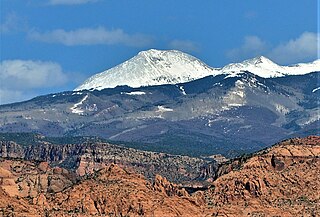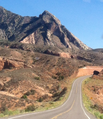
Grove Karl Gilbert, known by the abbreviated name G. K. Gilbert in academic literature, was an American geologist.

The Henry Mountains are located in the southeastern portion of the U.S. state of Utah and run in a generally north–south direction, extending over a distance of about 30 miles (50 km). They were named by Almon Thompson in honor of Joseph Henry, the first secretary of the Smithsonian Institution. The nearest town of any size is Hanksville, Utah, which is north of the mountains. The Henry Mountains were the last mountain range to be added to the map of the 48 contiguous U.S. states (1872), and before their official naming by Thompson, were sometimes referred to as the "Unknown Mountains." In Navajo, the range is still referred to as Dził Bizhiʼ Ádiní.

Mount Hillers is a summit in the Henry Mountains range, in Garfield County, Utah, in the United States. Its elevation is 10,741 feet (3,274 m) NAVD 88.

South Mountain is an 11,798-foot (3,596 m) peak in San Juan County, Utah in the United States, about 5 miles (8.0 km) north of La Sal, Utah. It is part of the La Sal Mountains. Precipitation runoff from this mountain drains into tributaries of the Colorado River. The nearest town is Moab, 20 mi (32 km) to the northwest, and the nearest higher neighbor is Mount Tukuhnikivatz, 2.64 mi (4.25 km) to the north.

Mount Spry is a small 5,720-ft elevation mountain summit made of Navajo Sandstone located in Zion National Park, in Washington County of southwest Utah, United States. Officially named in 1934, it honors William Spry (1864-1929), the third governor of Utah. The nearest higher peak is The East Temple, 0.34 miles (0.55 km) to the east. Precipitation runoff from the mountain drains into tributaries of the North Fork Virgin River.

The East Temple is a prominent 7,709 feet (2,350 m) summit made of Navajo Sandstone in Zion National Park, in Washington County of southwest Utah, United States. It is one of the notable landmarks in the park. The nearest neighbor is Twin Brothers, one half mile to the north, and the nearest higher peak is The West Temple, 3.85 miles (6.20 km) to the west-southwest. The mountain is situated 1.8 miles northeast of the park headquarters, at the confluence of Pine Creek and the North Fork Virgin River. The first ascent was made in 1937 by Glen Dawson, Dick Jones, Homer Fuller, Wayland Gilbert, and Jo Momyer.

Mount Moroni is a 5,690-foot (1,730 m) elevation Navajo Sandstone summit located at the Court of the Patriarchs in Zion National Park, in Washington County of southwest Utah, United States.

The Sentinel is a 7,120+ ft elevation Navajo Sandstone summit located near the Court of the Patriarchs in Zion National Park, in Washington County of southwest Utah, United States. The national park map lists the elevaton as 7,157-feet.

Cathedral Mountain is a 6,930-foot (2,110 m) elevation Navajo Sandstone summit located in Zion National Park, in Washington County of southwest Utah, United States. Cathedral Mountain is situated at the north end of Zion Canyon, towering 2,500-feet above the canyon floor and the North Fork of the Virgin River which drains precipitation runoff from this mountain. Cathedral is the nearest higher neighbor to Angels Landing, with 0.7 mile of separation, and the Angels Landing Trail traverses Refrigerator Canyon between them. Other neighbors include The Great White Throne, Observation Point, The Organ, Lady Mountain, Cable Mountain, and parent Mount Majestic. This feature's descriptive name was applied by Stephen S. Johnson in 1922, and officially adopted in 1934 by the U.S. Board on Geographic Names. The Spearhead, elevation 5,804-ft, is the southernmost tip of this mountain, and is prominently featured from Zion Lodge. The first ascent of Cathedral was made by Walter Becker, Fritz Becker, and Rudolph Weidner on August 31, 1931.

Altar of Sacrifice is a 7,505-foot elevation Navajo Sandstone summit located in Zion National Park, in Washington County of southwest Utah, United States.

Mountain of the Sun is a 6,722-foot (2,049 m) elevation Navajo Sandstone summit located in Zion National Park, in Washington County of southwest Utah, United States. Mountain of the Sun is situated immediately east of Court of the Patriarchs, and south of Zion Lodge, towering 2,500-feet above the lodge and the floor of Zion Canyon. It is set on the east side of the North Fork of the Virgin River which drains precipitation runoff from this mountain. Its neighbors include The Sentinel, Mount Spry, The East Temple, and Mount Moroni. This feature's name was officially adopted in 1934 by the U.S. Board on Geographic Names.

Mount Majestic, also known as Majestic Mountain, is a 6,956-foot (2,120 m) elevation Navajo Sandstone double-summit mountain located in Zion National Park, in Washington County of southwest Utah, United States. Mount Majestic is situated near the north end of Zion Canyon, towering 2,600-feet above the canyon floor and the North Fork Virgin River, which drains precipitation runoff from this mountain. Majestic is the parent to Cathedral Mountain, with only 0.24 mile of separation between them. Other neighbors include The Great White Throne, Observation Point, Red Arch Mountain, Lady Mountain, Castle Dome, Cable Mountain, and Angels Landing. This feature's name was officially adopted in 1934 by the U.S. Board on Geographic Names.

Twin Brothers is a 6,863-foot (2,092 m) elevation Navajo Sandstone summit located in Zion National Park, in Washington County of southwest Utah, United States. Twin Brothers is situated one half mile immediately north of The East Temple, and one half mile immediately south of Mountain of the Sun, towering 2,800-feet above the floor of Zion Canyon. It is set on the east side of the North Fork of the Virgin River which drains precipitation runoff from this mountain. Its neighbors across the canyon include Bee Hive, The Sentinel, and Mount Moroni. Mount Spry, set southwest and below Twin Brothers, often appears in photos taken of both from park headquarters. This feature's name was officially adopted in 1934 by the U.S. Board on Geographic Names.

Ivins Mountain is a remote 7,019-foot elevation Navajo Sandstone summit located in Zion National Park, in Washington County of southwest Utah, United States.

The Sundial is a 7,590-foot elevation white Navajo Sandstone summit located in Zion National Park, in Washington County of southwest Utah, United States.

Mount Pennell is a prominent 11,413-foot elevation summit located in eastern Garfield County, Utah, United States. Mount Pennell is the second-highest mountain in the Henry Mountains, following Mount Ellen, 10.6 miles to the north. It is situated in a dry, rugged, and sparsely settled region east of Capitol Reef National Park, on primitive land administered by the Bureau of Land Management. Several deep canyons cut the sides of the mountain, which on the higher slopes supports oak, Ponderosa pine, subalpine fir, spruce, Douglas fir, and aspen. Precipitation runoff from this mountain drains into tributaries of the nearby Colorado River.

Mount Holmes is a 7,998-foot elevation summit located in eastern Garfield County, Utah, United States. Mount Holmes is part of the Henry Mountains. It is situated in a dry, rugged, and sparsely settled region west of Glen Canyon National Recreation Area, on primitive land administered by the Bureau of Land Management. Precipitation runoff from this mountain drains into tributaries of the nearby Colorado River, which here is Lake Powell six miles to the east of this mountain.

Bull Mountain is a 9,187-foot elevation summit located in northern Garfield County of Utah, United States. Bull Mountain is part of the Henry Mountains which are set between Capitol Reef National Park to the west, and Glen Canyon National Recreation Area to the east. Mount Ellen is immediately southwest of Bull Mountain, and Burr Desert spreads out to the northeast. It is situated in a dry, rugged, and sparsely settled region, set on primitive land administered by the Bureau of Land Management. Precipitation runoff from this mountain drains into tributaries of the Colorado River. The nearest town is Hanksville, 17 miles to the north, and Robbers Roost is 20 miles to the northeast.

Mount Tukuhnikivatz is a 12,482-foot elevation summit located in San Juan County of Utah, United States. Mount Tukuhnikivatz is the third-highest peak of the La Sal Mountains, and is the premier ski mountaineering destination in the La Sals. It is situated in a dry, rugged, sparsely settled region, and set on land administered by Manti-La Sal National Forest. Precipitation runoff from this mountain drains into tributaries of the Colorado River. The nearest town is Moab, 19 mi (31 km) to the northwest, and the nearest higher neighbor is Mount Peale, 1.7 mi (2.7 km) to the east. The mountain's name is a Native American word that translates as "Where the sun sets last." Locals call it Mount Tuk for short. This mountain has a subsidiary peak unofficially called Little Tuk, approximately one half mile to the north-northwest.

Mount Mellenthin is a 12,645-foot elevation summit located in San Juan County of Utah, United States. Mount Mellenthin is the second-highest peak of the La Sal Mountains. It is situated in a dry, rugged, sparsely settled region, and set on land administered by Manti-La Sal National Forest. Precipitation runoff from this mountain drains into tributaries of the Colorado River. The nearest town is Moab, 20 mi (32 km) to the northwest, and the nearest higher neighbor is Mount Peale, 1.7 mi (2.7 km) to the south. The mountain's name honors Rudolf E. Mellenthin (1884–1918), forest ranger of La Sal National Forest, who was shot to death near this peak on August 23, 1918, while attempting to apprehend two draft evaders. This geographical feature's name was officially adopted in 1932 by the U.S. Board on Geographic Names.

























